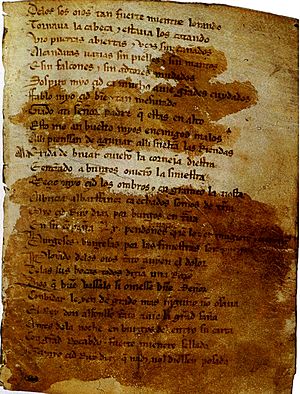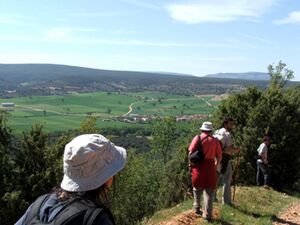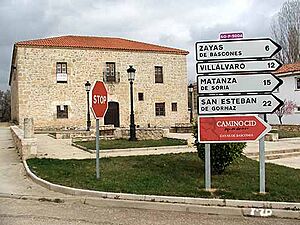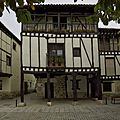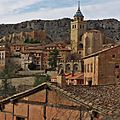Camino del Cid facts for kids
The Way of El Cid is a special travel route across Spain. It goes from the northwest to the southeast, from Castilla to the Mediterranean Sea. This route follows the adventures of a famous knight named El Cid Campeador. He lived in the 11th century and was a real person, not just a story character!
The main guide for this journey is a very old poem called the Cantar de mio Cid. It was written around the late 1100s or early 1200s. The poem tells about El Cid's adventures after he was sent away from his home. He had to fight against both Moors and Christians to survive.
The Way of El Cid crosses eight Spanish provinces: Burgos, Soria, Guadalajara, Zaragoza, Teruel, Castellón, Valencia, and Alicante. These provinces are part of four different regions of Spain: Castile and Leon, Castilla-La Mancha, Aragon, and Valencian Community. The whole route is very long, about 1400 kilometers for walking trails and 2000 km for roads. Because it's so long, the Way of El Cid is split into smaller routes. These smaller routes are connected and are usually between 50 and 300 km long.
Contents
Where the Way of El Cid Began
The Way of El Cid was inspired by the poem El Cantar de mio Cid. The poem mixes real history with made-up stories. The path El Cid took in real life isn't exactly the same as in the poem. The writer used real historical facts and his knowledge of geography. He created a route mostly along old Roman roads and trade paths.
People started traveling these paths as "Cid routes" in the late 1800s. Archer Milton Huntington, who started the Hispanic Society of America, was one of the first. Soon after, the language expert Ramón Menéndez Pidal and his wife Maria Goyri also looked for El Cid's traces. They explored the lands of Castilla and Aragon.
Most of the places mentioned in the poem can still be found on this route today. For example, a place called El Robledal de Corpes is mentioned. This is where El Cid's daughters faced a terrible challenge in the story. Many experts have been very interested in finding the exact location of this place.
Cool Places to See
The Way of El Cid has many interesting things to see. There are old medieval buildings listed as World Heritage Sites. In Burgos, you can see the amazing Gothic cathedral. Part of the Way of Saint James is also a World Heritage Site.
You'll also find Mudéjar Architecture of Aragon, which is a unique building style with Islamic influences. In Valencia, there's the Water Tribunal and the old Gothic Silk Market. The Festivity of La Mare de Déu de la Salut in Algemesí (Valencia) is also a World Heritage event. In Alicante, you can visit the Palmeral of Elche (a huge palm grove) and see the Mystery Play of Elche. About a dozen villages on the route have ancient cave paintings. These paintings are also a World Heritage Site.
The Way of El Cid passes through 39 villages that the Spanish government has named Historical and/or Artistic Sites. Some of these include Covarrubias (Burgos), Burgo de Osma (Soria), Sigüenza (Guadalajara), Calatayud, Ateca, and Daroca (Zaragoza). Also, Albarracín (Teruel), Morella (Castellón), Xàtiva (Valencia), and Elche and Orihuela (Alicante).
There are also beautiful natural places. You can see different styles of art like Romanesque, Mozarabic, Mudejar, Islamic, and Gothic. They all exist together in harmony. The landscapes are also stunning. These include the juniper fields in Arlanza (Burgos) and the Parque natural del Alto Tajo (Guadalajara). Don't miss the Laguna de Gallocanta (Zaragoza) or the Sierra de Maestrazgo (Teruel and Castellón). The lake and Natural Park of the Albufera de Valencia and the Palmeral of Elche (Alicante) are also amazing.
Much of the Way of El Cid goes through areas that were once borderlands. This means many castles, lookout towers, and military buildings are still standing. They were built in important spots to protect mountain passes and valleys. Some of these buildings have been fixed up, while others are now ruins.
How to Travel the Way of El Cid
You can follow the Way of El Cid in four main ways:
Hiking Routes
The hiking route of the Way of El Cid is about 1497 km long. It's divided into seven themed routes, each between 50 and 308 km. All these routes have signs. Most are approved as long-distance hiking trails (GR 160 – Way of El Cid). These paths mostly follow old historical routes and country roads. They go through plains, mountains, valleys, hills, and even along the coast. Anyone who enjoys long walks can do these routes. You don't need any special skills. You can find guides, maps, and places to stay for each route.
Mountain Biking Routes
The Way of El Cid for mountain bikes (MTB) is 1509 km long. It's also split into 7 signed routes, each from 49 to 313 km. You can use mountain bikes, all-terrain bikes, or even hybrid bikes with knobby tires. About 88% of the MTB route is the same as the hiking route. The other 12% uses special MTB paths. These paths help cyclists avoid very difficult hiking sections. They usually run along country or smaller roads. After the tough part, they connect back to the hiking route. All routes have signs. Hiking routes have their own signs, and MTB alternatives use international MTB signs.
Road Cycling Routes
The road cycling routes on the Way of El Cid are about 2041 km long. There are 10 routes, from 66 to 362 km long. These roads are mostly quiet, with little traffic. Some parts are on bigger regional or national roads. These usually have a wide shoulder for safety.
These routes are good for all types of bikes, from road bikes to all-terrain bikes. Gravel bikes and touring bikes are best because they are very versatile. They are faster than mountain bikes, especially on flat or downhill parts. They are also more comfortable than racing bikes on rough roads. Plus, you can easily switch to the mountain bike routes with these bikes. Many sections are easy and comfortable for touring bikes.
Car or Motorbike Routes
The road routes for cars or motorbikes on the Way of El Cid are 2021 km long. They go through many different types of landscapes. There are 11 routes, from 45 to 357 km each. You can combine these routes.
Most of the roads are unique, smaller roads. Some parts of the route are famous long-distance drives. Much of the route for vehicles is also the same as the route for road bikes.
The Way of El Cid Credential
The Letter of Safe Conduct is like a special passport for your journey. You collect stamps from the towns and villages you visit. This idea comes from the Middle Ages, when such documents helped travelers and goods move safely.
It's a great souvenir of your trip on the Way of El Cid. The stamps are very popular to collect! The collection was designed by Julián de Velasco. Each stamp tells you about a historical event, a legend, or something special about the local area.
The Letter of Safe Conduct also gives you discounts. You can get about 10% off at over two hundred places to stay along the Way of El Cid. You can also get special gifts like bracelets, badges, caps, or T-shirts. If you collect four stamps from at least seven of the eight provinces the Way crosses, you'll get a free Way of El Cid certificate!
The Letter of Safe Conduct is free. You can ask for it by mail or pick it up in person. Just visit any of the 81 Tourist Information Offices along the Way of El Cid.
Images for kids
See also
 In Spanish: Camino del Cid para niños
In Spanish: Camino del Cid para niños


